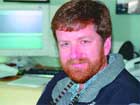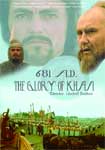
Kate & Leopold is just one Hollywood film for which Brad Carvey created special effects. He works out of his home in Albuquerque.
|
DUECE BENNETT: DIGITAL HITMAN
While Post might classify Jack "Deuce" Bennett of Creative Imagineering (www.cimagineering.com) in Lancaster, TX, as a guerrilla independent, a buddy of his prefers to call him a "digital hitman."
Bennett's boutique-style facility does computer graphics, visual effects, video production and editing for a wide variety of projects: corporate tapes, legal and government-contractor visualizations, commercials and more. Bennett even served as animation technical director for the movie Jimmy Neutron: Boy Genius.
Bennett took to computers at an early age, writing programs at nine.

At-home audio
|
But he followed a film-based freelance career path creating physical special effects for Lonesome Dove, RoboCop and Walker, Texas Ranger. It was on the latter series that Bennett began to migrate to video, doing all of the show's on-screen graphics.
Then Bennett joined his father, Jack, Sr., an advertising-agency executive, graphic designer and illustrator, in Creative Imagineering. At the core of the boutique is a complement of NewTek gear. "I've had NewTek stuff since I was 10," Bennett says. "I use LightWave more than anything else; it's my primary tool. I can do anything in it quickly, and it has an absolutely gorgeous renderer." Bennett helps steer beta programs for new LightWave releases talking to users and prospective users about where they need the software to go.
Creative Imagineering's large bull pen is outfitted with 10 dual-monitor workstations running Eyeon's Digital Fusion, LightWave, Photoshop and Illustrator. The company also has two Video Toaster 2 edit suites.

Foundry's Jeff O'Brien takes his Final Cut Pro, running on a laptop with a Kona SD card, on the road.
|
Bennett's business often attracts people "who feel they shouldn't be able to afford what we can do," he says. They marvel at Creative Imagineering's capabilities and express amazement that Bennett doesn't live in LA or New York.
Creative Imagineering can generate projects from script to screen. An aerospace client brought "a nebulous idea" for a video to be used internally and at trade shows, and Creative Imagineering crafted a script and storyboards to showcase the client's ground-based vehicles targeted for the year 2015. "We modeled the assets, set up surfaces, lights, did the animations for a previz and got approvals," Bennett explains. "Then we sent the files to the renderfarm and laid down the soundtrack and animation."

Kristian Kostov produces DVDs BG Media which imports classic Bulgarian films such as The Glory of Khan.
|
The company also worked with NASA scientists on visualizations of how comets and meteors are formed. A sequence depicts the Leonid meteor shower and why it is so difficult to predict the best viewing. One shot shows how small the body of a meteor can be. "We have a live shot of a guy holding a quarter and pull back to a CG shot that shows a meteor the size of a quarter is traveling so fast and its composition is such that its tail is longer than the Golden Gate Bridge," Bennett reports.
APARTMENT-baseD editing
Filmmaker Doug Morse recently realized his goal of making a feature film when he wrote and directed The Adulterer and helped cut it on an Avid Media Composer in his New York City apartment. Morse, who teaches screenwriting and producing at New York University and The New School, trucked in the Avid computer, monitors, mixing board and Beta SP deck "piece by piece in the back of a car. This was before the Xpress DV was readily available and Media Composer was the system required to cut any feature, low budget or high end."

He is also working with Senseis Massimo di Villadorada on a martial arts DVD.
|
Morse hadn't considered himself an editor before the Media Composer arrived in his apartment. He had used early versions of Adobe Premiere for home editing before and didn't enjoy the experience. For The Adulterer, Morse hired a lead Avid editor, David Kother, who did the first cut and an editing team who picked up the reins when the lead editor was not available. A member of that team, Steve Perrotta, showed Morse how to use the Media Composer, and soon he was hooked. "I found myself waking up and saying we should try this with this scene," he recalls. "Media Composer has a wonderful interface; it's a great piece of equipment." After finishing The Adulterer (www.theadulterer.com), which won Best of Fest at the Sarasota Film Festival in February, Morse bought his own Xpress DV. "I steer all my students toward Xpress DV," he says. "It has pretty much the same interface as Media Composer but a smaller footprint. I have a dual-monitor set-up - you really need that for any editing project."
Morse is currently cutting a feature-length documentary on the Appalachian Trail, which he is making with his wife. "We spend seven to 10 days at a time in the field," he says. "We're shooting on Mini DV with Sony's TRV-900 3-chip camera. We initially wanted to tape people who were quitting the trail: 2,000 to 3,000 people start but only 200 to 300 complete the trail's 2,100 miles. But when we got out there it became apparent we had to interview and hike with as many people as we could, including those who were doing well."
Morse finds Xpress DV "easily handles massive amounts of footage," which is key to his documentary project. "Hard disk space is very cheap now, about $1 a GB. We have 300 gigs to hold hours and hours of material. Because we put digital video in and and get digital video out, there's no quality loss. We don't deal with Avid video resolutions: We see what we're going to get."
Morse says, "having an Avid in my home allowed me to say, 'I can do this.' Editing isn't about physically making cuts; it's about scenes, drama, pace, story."
The only downside he sees to guerrilla independent-style post is "because the equipment is so readily available, people go out and buy it without having a project. They think the technology is going to make them a filmmaker."
FROM ROCK TO VIDEO
Another apartment-based guerrilla independent is Kristian Kostov. A rock star in his native Bulgaria, he emigrated to Canada with his band in the mid-1990s but didn't exactly take North America by storm. So Kostov parlayed his interest in the power of sound and picture - he performed with projected images he had created and synched songs and visuals - to co-found the Montreal-based video company, La Boite Orange.
Last year Kostov sold his interest in the company and decided to strike out on his own as TranceFormMind Entertainment (www.tranceformmind.com), a company that combines his multimedia and audio skills (Kostov ran an audio studio half-a-dozen years ago). "I feel more free," says Kostov of his new enterprise. "The corporate world was more stressful and not meaningful." But as a guerrilla independent he acknowledges that "some projects are refused to us because we're independent. When you're trying to convince someone to spend $50,000 to $100,000 on a project, they want a more corporate environment."
TranceFormMind may not offer a conventional facility environment but no one can question Kostov's creativity and his company's professionalism. TranceFormMind, which occupies part of Kostov's apartment, has a roster of Matrox equipment at its core for realtime editing. "I've used Matrox technology for five or six years and love it," Kostov says. "The realtime capabilities and 3D effects really help with my work." He employs the powerful DigiSuite DTV, a 50 Mbps system, on the DVCPro50 format to give him "Digital Betacam quality." He also runs Apple's Final Cut Pro RT.
In addition, Kostov has a PC with RT-2000 running Premiere 6.5 and After Effects. His DVD authoring platforms are Apple's DVD Studio Pro and DVD Maestro; he favors the latter for Macrovision copy protection. His chief audio tool is Logic Audio, which allows him to do surround work.
Kostov's credits are extremely varied. Thanks to his multimedia expertise, he's often able to suggest deliverables that the client hasn't considered. "They may not have the marketing experience to know about linking to other areas," he explains. After mastering an album for rock artist Babou, Kostov suggested a Web site to sell the product and a CD Extra which connects to the site. Kostov created video-style elements from still photos for the CD Extra and added details about Babou's upcoming dates and his other musical side.
"People get a lot more value without spending a lot more by doing combination projects," Kostov points out. "Because I can do everything at TranceFormMind, I can package my services."
Kostov produces entire DVDs - graphic design, sound logos, soundtracks, DVD authoring - for Utah-based BG Media, which imports classic Bulgarian films such as Time of Violence and The Glory of Khan.
He also does his own projects such as The Rhythm of Aikido, a martial arts education DVD in five languages, and 9 Senseis, another martial arts DVD. He has launched a Web TV station distribution channel, one of whose channels is dedicated to martial arts. Kostov plans to set up another channel for BG Media's product line.
GUErRILLA HYBRID
Digital Foundry, the post production arm of Portland, OR's Picture This Production Services (www.pixthis.com), is something of a guerrilla independent hybrid. Its permanent facility has three nonlinear editing rooms, two running Final Cut Pro (FCP) and one with a Media 100 system, which will soon be converted to another FCP workstation. Editors cut material that Picture This has shot on film, video and HD for clients like TLC, Discovery, MTV, VH-1, BBC and for its own clients.
But Digital Foundry can also pack light and move quickly when customers, primarily from the corporate market, require on-location editorial. "Editing on location has evolved for us over the years," notes chief editor Jeff O'Brien. "We started taking a Media 100 on the road, but that was cumbersome. Then we moved to Final Cut Pro on a G4 desktop with a DVD burner. Now the speed, throughput and screen size are such that we're able to use Final Cut Pro on a G4 laptop."
The laptop's 15-inch screen with a more horizontal orientation is a welcome new addition, O'Brien says. Editors always make sure they have extra FireWire drives on hand.
The migration to a laptop poses fewer problems to airline security measures in the wake of September 11. "Carrying computers in your baggage just doesn't work anymore," O'Brien reports. "With the laptop, which we'll soon use in Cabo San Lucas, Mexico and in Rome, Italy, we can just carry it onboard."
One of Digital Foundry's clients, which develops and supplies computer systems to auto dealers, is keeping editor Brian Willis busy with on-the-spot event editing at conventions and sales incentive meetings. "These events are usually fairly scripted: There's a storyline you follow," reports O'Brien who is also a veteran of the on-site projects. "At a convention in Hawaii they re-enacted Easy Rider with a road movie about guys looking for the client and their party."
O'Brien and his colleagues value FCP for its flexibility when time is short and amenities are few on location. "It's a simple editing tool that has the complexity you need to do composites without going all the way to After Effects, which is also resident on our systems," O'Brien says.
The FCP systems in Digital Foundry's facility have AJA Kona SD cards, which allow for uncompressed editing. "The beauty of Final Cut Pro is that it can operate as a front end to any number of cards," explains O'Brien. "It will eventually be the front end for an HD editing system here. We have the first part of the equation with an HD camera and deck at Picture This. But before we move over to HD editing we need clients to tell us they want to deliver on HD."